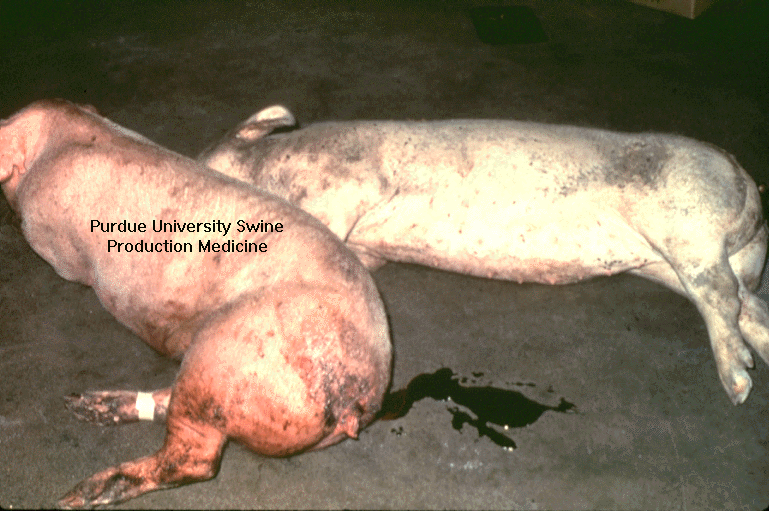Purdue Pork Page Archive
This material is for informational
purposes only. You cannot definitively diagnose the cause of diarrhea just
by looking at affected pigs. Please consult your veterinarian for a diagnosis
and proper treatment
Growing/Finishing Diarrheal
Diseases

The six causes of diarrhea that we are most likely to find in growing
and finishing pigs are Transmissible Gastroenteritis (TGE), Proliferative
Ileitis, Hemorrhagic Bowel Syndrome, Salmonella, Swine Dysentery, and Whipworms.
1. TGE
Signs:
- Diarrhea and vomiting in all ages of pigs.
- Older pigs may not be as severely affected.
- Diarrhea and vomiting may occur in gilts and sows.
- Yellow, watery diarrhea occurs in baby pigs.
- There is a high death loss in the younger pigs but this decreases with
age.
- TGE most commonly occurs in the winter.
Necropsy:
- Fluid content in the small intestine.
- Thinning of the bowel wall.
- Villous blunting
- Clear lacteals
Treatment:
- Consult your veterinarian.
Prevention:
- Optimize sanitation.
- Maximize biosecurity especially in the winter.
2.
Proliferative Ileitis
Signs:
- (Non-bloody-proliferative ileitis) Weight loss and dark stool with
"cow-pie" consistency.
- (Bloody-acute hemorrhagic proliferative enteropathy) The stool may
be dark, tar-like, or bloody or may just contain flakes of blood.
- Sudden death may be the result of the bloody diarhhea.
Necropsy:
- (Non-bloody) Greatly thickened lining of the small intestine which
is often referred to as a "garden hose" gut.
- (Bloody) Thickened segments of the small intestine containing blood
clots.
Treatment:
- Consult your veterinarian.
Prevention:
- Consult your veterinarian.
- Optimize sanitation
3.
Hemorrhagic Bowel Syndrome
Signs:
- Pigs weigh >150 pounds
- Similar to bloody form of proliferative ileitis.
- Stool may be dark, tar-like, or bloody.
- Severe bleeding into the intestine which may result in sudden death.
Necropsy:
- Blood filled loops of small intestine.
- Thinning of small intestinal wall with no proliferation of intestinal
cells.
Treatment:
- Consult your veterinarian.
Prevention:
- Consult your veterinarian.
- Optimize sanitation.
4. Salmonellosis
Signs:
- Fever, depression, and generalized systemic disease such as pneumonia.
- Affected pigs may have purple ears and extremities.
- Affected pigs may have golden-yellow diarrhea which may or may not
contain blood.
- Pigs may die if not treated.
Necropsy:
- Swollen spleen, liver, and lymph nodes.
Treatment:
- Consult your veterinarian.
Prevention:
- Optimize sanitation.
- All-in, all-out pig flow through grower and finisher buildings.
- Pressure washing and disinfecting of rooms between groups of pigs.
- Vaccines are available.
- Consult your veterinarian for further details.
5.
Swine Dysentery
Signs:
- Bloody diarrhea which sometimes contains pieces of dead tissue and
is sometimes referred to as "Rice Water Diarrhea".
- The affected pigs are very weak and rapidly lose weight.
Necropsy:
- Large intestine may be filled with blood mixed with mucous, bacteria,
and other dead intestinal cells.
Treatment:
- Consult your veterinarian.
Prevention:
- Maximize your biosecurity.
- Optimize sanitation.
- Control rodents.
6.
Whipworms
Signs:
- Bloody diarrhea in pigs at least 8 weeks old.
- The affected pigs may be off- feed, depressed, and may often die if
not treated.
Necropsy:
- Whipworms measure about 2 inches in length and are shaped like a whip.
They can be found in the cecum and colon.
Treatment:
- Consult your veterinarian.
Prevention:
- Optimize sanitation.
- Washing of sows before they enter the crates.
- Strategic deworming consult your veterinarian for details.
Purdue Pork Page Archive

